松露知识
松露简介
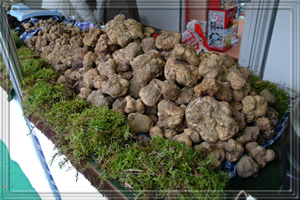
松露是一种多生长在松树、栎树、橡树下,一年生的天然真菌类植物。因其栉松风、沐晨露而长,故日语名曰西洋松露(シヨウロ),又称“地菌”、“块菰”、“块菌”;因其是被猪从地下拱出,国人称“猪拱菌”、“拱菌”,亦称“无根藤果”、“隔山撬”;法国名“perigord truffle”,英国名“truffle”。属真菌门、子囊菌纲、块菌目、块菌属食用真菌。它与肥鹅肝、鱼子酱合称为“法国三大美食珍品”,年消费量为草菰的两倍。
松露子实体块状,小者如核桃,大者如拳头。幼时内部白色,质地均匀,成熟后变成深黑色,具有色泽较浅的大理石状纹理。多生长在栎树下深达30厘米的钙质土壤中,腐生性。常共生在树根上形成菌根(mycorrhiza)。子囊具1~4枚孢子,形大。法国植物学家图尔纳福尔于1701年首次观察到松露的子囊孢子。子囊果球形、椭圆形,棕色或褐色,有的小如豆,也有大如富士苹果,表面具有多角形疣状物,反射出红色的光泽,顶端有凹陷;其肉(产孢子组织)初为白色,后呈棕色或灰色,成熟时变黑色;切面呈褐色,具有大理石样纹,散发出森林般潮湿气味,并带有干果香气,借以引诱小动物前来觅物,将孢子带到他处进行繁殖。
松露历史
古代:
松露最早出现在新苏美尔的铭文, 铭文上记载了亚摩利人的饮食习惯,说他们常常吃松露。 几个世纪后,泰奥弗拉斯在他的笔札上又提及松露。从科学文献来看,松露三亿六千万年前已经在这个世界上, 比人类出现得更早. 在古生代时期, 由于甲虫的回游, 孢子开始遍布全世界. 人们在北美和意大利发现了一些化石,其中有一个化石很特别,它三亿年前就在意大利的皮埃蒙特(Piemonte)省一直处于休眠状态!
在古代,松露的起源是一个神秘的话题,很多哲学家作家提出不一样的假设. 公元前3000年,巴比伦人已经在海滩和沙漠寻找松露. 古希腊故事提及阿佛洛狄忒(爱情女神)特别爱吃这个蘑菇(菲罗玄的莱夫卡斯(Philoxenus of Lefkas)率先在笔札中谈及松露具有春药的效力). 普鲁塔克(Plutarch)认为松露是雷,女巫的温暖技能和土壤中的水综合作用的结果. 朱韦纳尔 (Juvenal) 认为雷与雨影响松露的出现. 西塞罗(Cicero)认定松露是土地的儿子, 而迪奥斯科里季斯(Dioscorides)认为它们是块茎根. 一个传说认为松露是被宙斯(Zeus)的雷引发的. 在古代,意大利有两种松露: Tuber Melanosporum (冬季黑松露 , 黑孢块菌) 与 Tuber Magnatum Pico (白松露 , 白块菌). 尽管如此,罗马人只使用铁飞兹(terfez),一种形似松露的蘑菇。 铁飞兹被称为”沙漠松露”.它产自莱斯沃斯岛(Lesbos Island),迦太基(Carthage),尤其是利比亚(Libya)。因为在古时候那些地方的沿海气候要比现在潮湿
中世纪:中世纪时期,农民使用松露来调味. 意大利的萨沃亚(Savoia)家族特别喜欢松露, Acaja王子给波旁王朝(Bourbons)的礼物中常常有松露. 教皇从罗马迁居到阿维尼翁(Avignon)后发现了松露并且爱上了它们, 每个星期都吃。 巴特鲁姆普拉提纳 (Bartolomeo Platina)教皇的历史家1481年时记载了寻找松露的事情,他写道,”有一种母猪特别擅长寻找松露,可是人们应该让它们戴上口套,以避免它们将松露吃个精光!.
文艺复兴:文艺复兴时期,松露在欧洲重新流行,它们在法国国王弗朗西斯一世(Francis I of France)的城堡里天天出现. 尽管如此,松露真正的盛行是从17实际开始的。那时的欧洲人(特别是法国人) 放弃重口味的东方香料, 重新发现天然食品的价值. 十七世纪八十年代松露在巴黎市场是非常受欢迎的美食,法国人全年从松露产区进口各种各样的松露. 布里亚萨-萨瓦林(Brillat-Savarin, 1825) 说了:”松露是如此之贵,以至于它们只出现在贵族的餐桌上用以吸引女性。”. 那个时候出现的火鸡加松露特别好吃, 连罗西尼(Rossini - 很有名的意大利音乐家)都说: “在我生活中我只吃过松露三次: 第一次是在我的第一个歌剧失败的那一天,第二次是我听帕格尼尼拉演奏小提琴的时候,第三次火鸡在泛舟的野餐中被打翻了。文艺复兴时期,人们更加注重研究松露的历史,显而易见的,这并没有改变他们对松露的喜爱。 松露一直出现在凡尔赛宫(Versailles)皇宫里,.并且越来越多的学者开始研究它们,但是,直到 1699年,英国学者翰雷 (John Ray)终于在松露里发现一些微观结构,这些微观结构后来被称之为孢子
1700 - 现代:1711年,法国植物学家艾蒂安弗朗索瓦若弗鲁瓦 (Etienne François Geoffroy) 第一次将松露定义为一种蘑菇. 1729年,佛罗伦萨来的乔瓦尼贝尔纳多维哥(Giovanni Bernardo Vigo) 准确地定义两种黑松露: 黑孢块菌 (Tuber Melanosporum) 与夏块菌(Tuber Aestivum). 1780年,波兰的让米歇尔博尔奇 (Michel-Jean de Borch), 在他的 “关于皮埃蒙特松露的家书”里准确的描述了皮埃蒙特松露的外形和口感. 于尔班杜布瓦 (Urbain Dubois)在他的两本书(经典菜, 每个国家的菜 “La Cuisine de touts les pays” and “Cuisine Classique”)里提到了意大利松露的美味,并且给予了很多食用松露的建议。
19世纪末,Giuseppe Gibelli教授在都灵大学发现菌根后开始研究松露的栽培. 几年后
一位农民有个好主意: 播种一些橡树的橡子,因为黑孢块菌一般生长在橡树下,这样,一年后他得到了一些黑松露.
20世纪,意大利的白松露在世界上越来越有名(Alba, Acqualagna)。第二次世界大战后,蒙费拉托(Monferrato),罗埃罗(Roero,),Monregalese,瓦利库罗内(Valli Curone),格吕埃(Grue),Ossona和Borbera地区的人们都在积极的收集白松露。现在,松露在很多国内国际博览会有很重要的地位。
Truffles’ kinds
The classification of different species of truffles is based primarily on morphological characteristic such as shape, size, colour, ornamentation of the peridium, trama aspect, smell and taste.
The different species are identified in the laboratory through the recognition of spores or through molecular-biological analysis techniques.
In the world of fungi species there are about 63 that are currently classified as tubers; in Italy there are 25, but only 9 are edible and 5 are the most commonly marketed: Tuber Magnatum Pico, Tuber Melanosporum Vitt.,Tuber Aestivum Vitt., Tuber Borchii Vitt. and Tuber Brumale Vitt.
White truffle (Tuber Magnatum Pico)
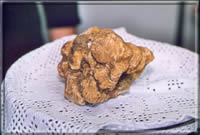
The white truffle (Tuber Magnatum Pico) is the most widely known truffle because of its taste and commercial importance.
It has a globular shape, with numerous depressions on the peridium that make it irregular. The outer surface is smooth and slightly velvety. The colour varies from pale cream to dark cream to greenish. Its flesh is unmistakable and it is white or greyish yellow with thin white veins.
It smells pleasantly aromatic and contrary to other types of truffles it does not have a garlic-like smell. This makes it unique. It lives in symbiosis with oak trees (in this case it takes a dark hazelnut colour), lime trees, poplars and willows (in this case it is almost white) and is rarely found in combination with other truffles. It also has red marks if it lives in symbiosis with the linden. The white truffle, to sprout and grow, needs special terrain with equally unique climatic conditions: Soil should be soft and wet for a better part of the year; soil must also be rich in Calcium and a good circulation of air is desirable. The collection is done from September to December.
Black Truffle (Tuber Melanosporum Vitt.)
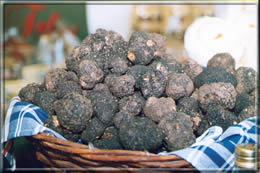
The black truffle (Tuber Melanosporum Vitt.) looks fairly smooth and round with polygonal warts. The black winter truffle has a trama that acquires a blackish shade of purple when fully ripe. The main characteristics to distinguish the different species are: the soil, the plants with which the truffle has a symbiotic relationship and the area or the countries in which the truffle grows. The black truffle is found in France (Perigord, Vaucluse) and in Norcia, Umbria. That is why the black truffle is known as The Norcia or Perigord black truffle. The flesh is clear, its perfume is intense, aromatic and fruity.
It grows in hilly and mountainous areas in symbiosis with hazel and oak. After the white truffle, it is considered the most valuable commercially and is a significant ingredient in international cuisine. Its collection period is from December to March.
Black Summer Truffle (Tuber Aestivum Vitt.)
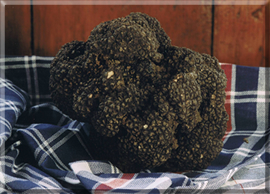
The black summer truffle sometimes reaches big dimensions and looks similar to the black winter truffle. The external surface has brown colored pyramidal warts. It has an aromatic smell, but once cut it is possible to distinguish it from the black winter truffle because the gleba does not become dark and instead acquires a dark yellow color.
It grows both in sandy and clavely soils. It is well appreciated and used for the production of sausages and sauces.
Bianchetto (Tuber Borchii Vitt.)
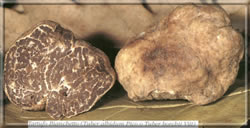
“Bianchetto truffle” also known as “Marzuolo truffle” (Tuber Borchii Vitt.) is abundant in Tuscany, Piedmont and Marche regions. Externally it can be confused with the Tuber Magnatum because at a first glance it shows the same characteristics: irregular, smooth and off-white color but the difference is that when it ripens, it becomes darker. Even the trama (also called the context or flesh) from fair become darker. The smell is the main characteristic that distinguishes it from the white truffle, because if it is soft and pleasant at the beginning, it becomes garlic-like and nauseating after some time. It grows in limestone soils, often in deciduous and coniferous trees. The collection period is from January to March.
Black winter Truffle (Tuber Brumale Vitt.)
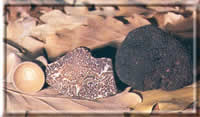
Black Winter Truffle or Brumale (Tuber Brumale Vitt.) is often confused with the black truffle because they share the same habitat and the same type of plant symbionts. It is brownish black with a slightly warty surface. Inside, the flesh darkens highlighting the white veins. It smells like nutmeg and grows in the winter under deciduous plants in temperate climates. Commercially its value is halved compared to the prized black.
Bibliography and images
- Tutto tartufo, Centro Nazionale Studii Tartufo
- Truffle_(fungi) (2009, November 20). In Wikipedia, the free encyclopedia. Retrieved November 20, 2009, from http://en.wikipedia.org/wiki/Truffle_%28fungi%29
- Where are the images of the website from?


